What is the Application Lifecycle Management (ALM) Market Size?
The global application lifecycle management (ALM) market size is valued at USD 4.71 billion in 2025 and is predicted to increase from USD 5.20 billion in 2026 to approximately USD 11.62 billion by 2034, expanding at a CAGR of 10.56% from 2025 to 2034. Continuously evolving software development with the latest development approach, known as agile methodology with CI/CD, is backed by a robust ALM system for smoother functioning, particularly in large organizations. The massive complexity of IT systems in these organizations is handled by the ALM, leading the smoother operations and seamless collaboration between the teams, which is leading to the development of superior quality software products, as per the industry standards. These factors are driving the growth of the application lifecycle management market.
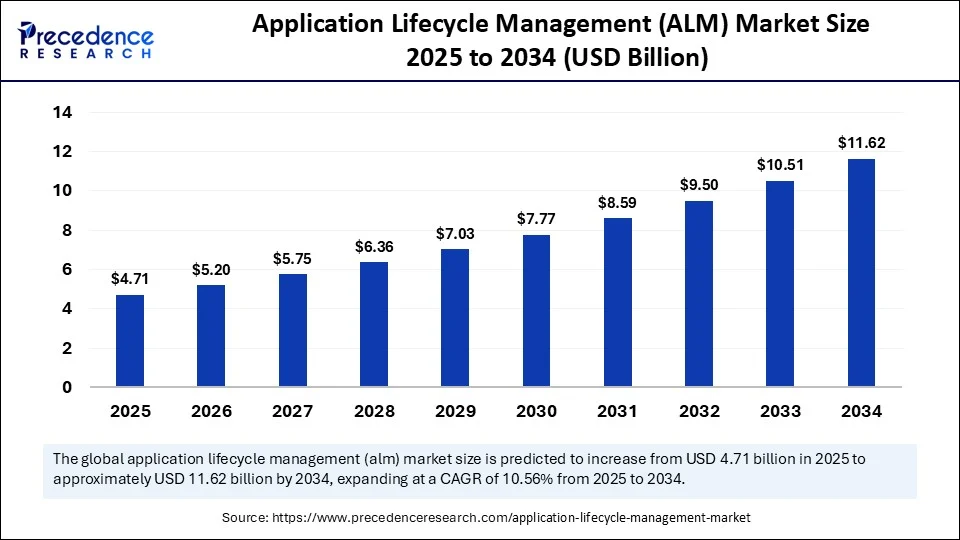
Application Lifecycle Management (ALM) Market Key Takeaways
- In terms of revenue, the global application lifecycle management market was valued at USD 4.26 billion in 2024.
- It is projected to reach USD 11.62 billion by 2034.
- The market is expected to grow at a CAGR of 10.56% from 2025 to 2034.
- North America dominated the application lifecycle management market with the largest share of 32% in 2024.
- Asia Pacific is estimated to expand at the fastest CAGR during the forecast period.
- By component, the Software/Platform segment captured the biggest market share of 56.23% in 2024.
- By component, the services segment showed the fastest growth during the forecast period.
- By deployment Mode, the Cloud (SaaS-based ALM platforms) segment held the highest market share of 68.32% in 2024.
- By deployment mode, the on-premises segment showed the fastest growth during the forecast period.
- By enterprise size, the Large Enterprises segment contributed the major market share of 71.22% in 2024.
- By enterprise size, the Small and Medium-sized Enterprises (SMEs) segment showed the fastest growth during the forecast period.
- By platform, the Web-based Applications segment generated the significant share of 59.33% in 2024.
- By platform, the Mobile-based Applications segment showed the fastest growth during the forecast period.
- By industry vertical, the banking, financial services, and insurance (BFSI) segment accounted for biggest market share of 34.13% in 2024.
- By industry vertical, the Information technology and telecom segment showed the fastest growth during forecast period.
How did AI Impact the Application Lifecycle Management Market?
Application life cycle management is a very fundamental software engineering approach in the software development life cycle. It is a collection of comprehensive tools for managing the application development, including requirement gathering, development, testing, bug finding and fixing, deployment, and maintenance. Throughout history, ALM has mostly been done with the help of manual processes, rule-based automation, and siloed tools. But as the technology is evolving and the complexity involved in the application is also increasing, the manual methods are becoming inadequate.
The latest technology is artificial intelligence, which is working incredibly in predictive maintenance, real-time monitoring, and improving the uptime and efficiency of the software product, with the latest evolution in artificial intelligence, such as generative AI. AI is helping in the automatic code generation based on specific requirements. It can assist developers in finding out the complexity in the code and detecting bugs, which is a highly crucial and time-consuming task that can be done in less time using the help of artificial intelligence integration. Automated testing with AI tools can produce various test cases for the detailed analysis, which leads to significantly reducing efforts in manual testing while improving the test coverage.
Predictive analysis is highly effective in finding potential issues and ensuring the implementation of product measures to mitigate future malfunctions in the software project. Overall, the AI integration in the ALM process has enhanced the overall process by reducing the time efforts and increasing the accuracy and productivity of the entire system, leading to the delivery of a high-quality software product in a limited time.
Market Overview
What is Application Lifecycle Management (ALM)?
Application Lifecycle Management (ALM) encompasses the governance, development, testing, maintenance, and eventual retirement of software applications. It integrates requirements management, project planning, development, test automation, release deployment, change control, and ongoing support across the entire software lifecycle. ALM helps in improving product quality, productivity optimization, and making the entire process highly convenient for management and the maintenance team by reducing the unnecessary burden related to products and services.
In ALM, a dedicated team of engineers ensures that the tools and processes that supervise a software application from its inception, planning, development, testing, maintenance, and decommissioning of the product, from start to end, this team takes care of the entire software development life cycle. The use of application life cycle management tools helps to automate the software development process and deployment of the product to ensure compliance and maintain a standard environment where the collaboration of the entire team works smoothly for the application life cycle, and communication throughout the entire team stays clear and concise.
What are the Growth Factors of the Application Lifecycle Management Market?
- The increasing adoption of Agile and DevOps as the SDLC methodologies is based on robust ALM solutions for smoother functioning. Continuous integration, continuous delivery pipelines, and continuous collaboration across teams are highly beneficial for seamless and faster development cycles for software products.
- The seamless collaboration and communication between teams help to develop high-quality software and deploy it at a very fast pace.
- The rise in adoption of cloud-based applications and services is creating demand in the market for cloud native ALM solutions.
- The solutions are highly scalable, flexible, and accessible, which makes them highly convenient in the process of software development and deployment in a cloud environment.
- Considering the rising pressure for maintaining regulatory standards and maintaining the high-quality software delivery, ALM solutions utilisation is increasing in the market, which provides robust testing capabilities and version control, which are very fundamental requirements for the development and deployment of high-quality software products.
- With the help of AI tools integrated in ALM platforms, features like automated code generation, intelligent testing, and predictive maintenance lead to improved code quality and help developers accelerate development while optimizing the application performance in real time.
- ALM solutions also incorporate security testing and vulnerability management, and compliance features amid the rising sophisticated cyber threats, leading to an increased demand for application security. This integration helps the organisation to deploy secure software products in the market.
Application Lifecycle Management (ALM) Market Outlook
- Industry Growth Overview: The ALM market is expected to grow rapidly from 2025 to 2030, fueled by enterprise transition to complex, multi-cloud environments and the need for unified platforms to enable faster releases. The need for automation, integrated DevOps, and real-time visibility is driving adoption in North America, Europe, and APAC.
- Global Expansion: Prominent ALM vendors are expanding into Southeast Asia, Eastern Europe, and LATAM to address the rising needs associated with digital transformation. Many of these companies are creating regional hubs for R&D and support, to facilitate shorter deployment cycles and serve the rapidly growing software development communities.
- Key Investors: Private equity (PE) firms and strategic investors are entering the ALM market because of strong recurring revenue models, large switching costs, and multi-year contracts. Investments have been focused on cloud native ALM tools, DevSecOps platforms, and combined test automation.
- Startup Ecosystem: The ALM startup space is growing with strong interest in AI-based test automation, low-code application development governance, and predictive quality analytics. Startups providing code intelligence, automatic compliance, and cloud-native lifecycle control solutions have also gained considerable VC investment.
Marlet Scope
| Report Coverage | Details |
| Market Size by 2034 | USD 11.62 Billion |
| Market Size in 2025 | USD 4.71 Billion |
| Market Size in 2026 | USD 5.20 Billion |
| Market Growth Rate from 2025 to 2034 | CAGR of 10.56% |
| Dominating Region | North America |
| Fastest Growing Region | Asia Pacific |
| Base Year | 2024 |
| Forecast Period | 2025 to 2034 |
| Segments Covered | Component, Deployment Mode, Enterprise Size, Platform, Industry Vertical and Region |
| Regions Covered | North America, Europe, Asia-Pacific, Latin America, and Middle East & Africa |
Market Dynamics
Drivers
Increasing Software Complexity Driving the Growth of the ALM Market
The software development is becoming more complex and intricate, and is being distributed among teams using various technologies working in an interconnected environment. In this complex situation, ALM platforms are playing a crucial role in the management of the entire development life cycle, from requirement gathering to deployment and maintenance for the software development life cycle.The need for an ALM tool has risen significantly due to the increased complexity of software development, management, and maintenance processes. The rising complexity of software creates a substantial need for effective collaboration and communication between the teams. Many software developer teams are working in geographically diverse areas and remote locations, ALM providing them a standard platform for maintaining collaboration and communication for smoother flow and keeping all members on the same page while moving forward towards the common goal.
Restraint
High Deployment Cost and Compatibility Issue with the Existing Systems
The high deployment cost involved in the deployment of ALM systems with compatibility of existing systems is a major challenge faced by this market in the current times. This challenge is arising basically due to the complexity of the integration process involved with ALM solutions with diverse IT environments, legacy systems, and third-party tools. The incompatibility of systems leading to data silos creating visibility hindrance in the software development life cycle, leading to inconsistencies and errors during the operations. By implementing various customizations and API development, this compatibility can be achieved with diverse systems, and many organizations have successfully implemented it.
Opportunity
Massive Demand for Agile Methodologies and Cloud-Native Applications
The focus of agile methodology is on a flexible and rapid deployment approach, integrated with scalability and efficiency of cloud native architecture, driving the requirement for ALM solutions that can support the modern development approach for faster and reliable software development and deployment. This rising requirement is driving the investment in the development of tools for streamlining the entire application life cycle from inception to development and deployment, with maintenance leading to generating higher potential in this market for growth in the upcoming time. Various customized solutions tailored according to specific business requirements offered by various ALM vendors are driving the growth of the industry on a significant level. Considering the specific requirements, many software developer organisations are actively opting for this specifically customised ALM solutions.
Component Insights
Software/platform segment dominates the application life cycle management market by component segmentation. All the necessary comprehensive suite of tools is included in this particular segment, which are highly essential for the management, development, testing, deployment, monitoring, and streamlining workflows of software development for ensuring seamless collaboration among the development teams. The ALM software includes all centralized tools and platforms for managing the application life cycle from the Inception of the software development till deployment and maintenance. The ALM software provides all essential requirements for definition, design, coding, testing, deployment, and monitoring related applications. During the entire software development life cycle process, it plays a crucial role in holding all the things in one place.
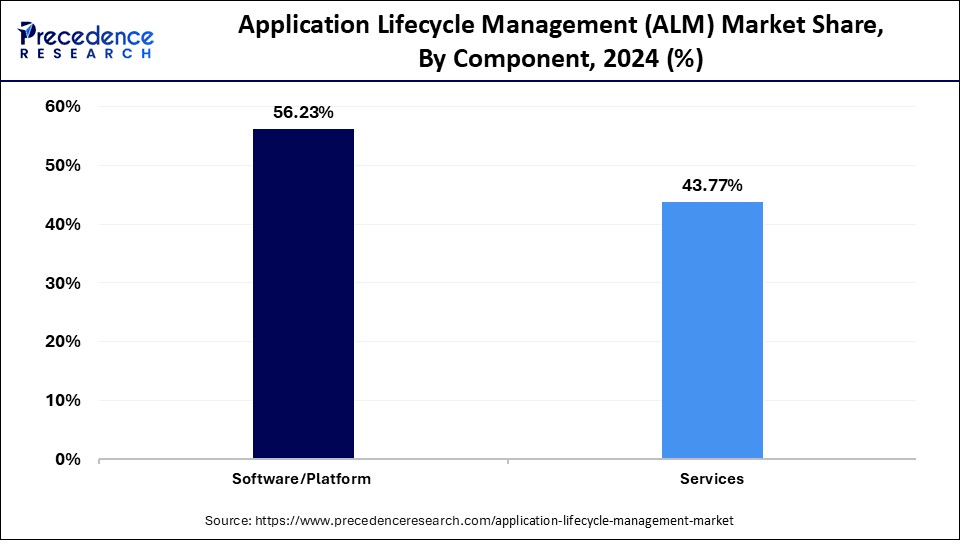
Services segment showing the highest growth rate in the application life cycle management market by component segmentation. The specialized expert ensures support required for ALM solutions optimization and streamlining the processes, primarily driving the growth in the service segment in the ALM market. Consulting, IT department integration, and ongoing support for maintenance services are highly demanded in the market. Demand for highly skilled professionals is continuously increasing in the market for this particular segment. IT Organizations, which have specialized and tailored solutions for specific business requirements, do require continuous service help to integrate ALM tools with their existing IT infrastructure. The continuous monitoring, updates, and performance tuning managed by the service provider ensure the seamless performance of ALM systems.
Deployment Mode Insights
The cloud-based ALM platforms are dominating the application life cycle management market by deployment mode segmentation. The cloud-based ALM solutions, including public, private, and hybrid models, show massive demand in the market due to flexibility, scalability accessibility at cost-effective prices offered by cloud solutions. Cloud services are not only restricted to large organisations; SMEs can also avail of cloud services as per their requirements, with the option of scalability, considering the changing business requirements.
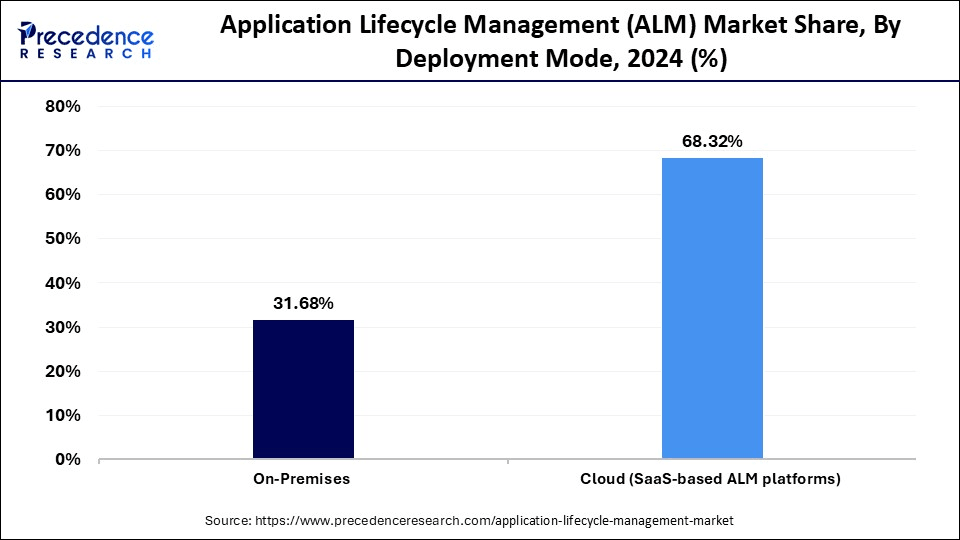
The on-premise segment is showing the fastest growth rate in the application lifecycle management market by deployment mode segmentation. The growth of on on-premises segment is attributed to the enhanced security requirements and customisation, with 100% infrastructure accessibility with greater control over the IT infrastructure. The increased security requirement and organisations where data security policy is highly stringent with strict compliance and regulations obtained for on-site data storage, the on-premise ALM ensures the straightforward implementation while maintaining industry-specific compliances regarding data security. High network latency is experienced in cloud solutions due to massive traffic and generalized infrastructure. On-premises solutions are relatively faster due to only private traffic on the infrastructure, which provides better control of systems compared to cloud platforms.
Enterprise Size Insights
The large enterprises segment dominated the application lifecycle management market by enterprise size segmentation. Large enterprises have complex software development requirements due to their massive scale of deployment and stringent regulatory compliance. Robust ALM solutions are deployed to manage multiple projects. To ensure collaboration across many teams simultaneously within the organisation. The integration of ALM systems with existing IT infrastructure and following the regulatory compliances while maintaining the standard are key requirements currently observed in the large enterprise segment for the application life cycle management market
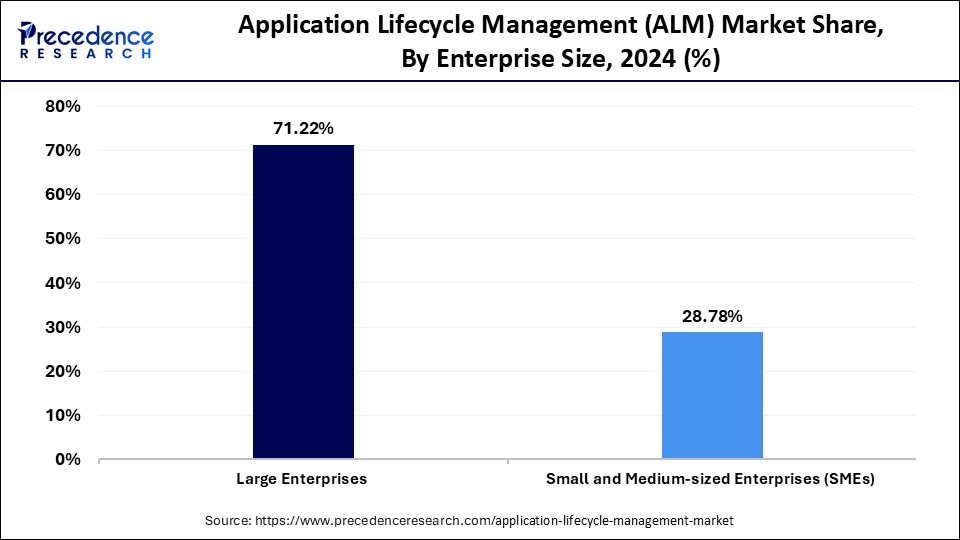
The small and medium-sized enterprises segment is showing the fastest growth in the application life cycle management market by enterprise size segmentation. The primary reason behind the increasing adoption of ALM solutions in small and medium organisations is driven by the requirement to enhance the product development process in these organisations while collaborating with many teams seamlessly and maintaining productivity in management for the large projects. The cost-effectiveness, accessibility, and scalability of cloud platforms have made it highly feasible for small and medium organisations to utilise these tools in their business operations, which is driving the growth of this particular segment very rapidly.
Platform Insights
The web-based application segment is dominating the application lifecycle management market by platform segmentation. The ease of integration of web-based applications, with DevOps and Agile methodology driving the dominance of this segment, the requirement for streamlined collaboration, efficient project management, and fast-paced product delivery is driving the growth. A centralized platform is offered by a web-based application for management of the entire application life cycle. Requirement gathering, design, testing, deployment, and maintenance, all the levels are performed with the help of the ALM system while maintaining transparency and controlling the process effectively.
Mobile-based application segment is showing the fastest growth rate in the application lifecycle management market by platform segmentation. The increased number of smartphone devices and the proliferation of 5G networks with the integration of advanced technology such as artificial intelligence and machine learning in smartphone devices are the primary contributors to the growth of mobile mobile-based application segment.
The increased computational power in mobile devices has enabled to use of them more than just for the basic functionality's majority of Smartphones available in the current market are capable of performing and running various mobile-based applications, which are used for business purposes. User-centric designs are opted for on mobile platforms to ensure a better user interface for convenience and simplification.
Industry Vertical Insights
Banking, financial services, and insurance segment dominated the application life cycle management market by industry vertical segmentation. Increased utilisation of technology in these segments, considering the sensitive customer data and complex financial transactions, robust security standards, which follow the regulatory compliances in BFSI, which leading towards the implementation of ALM for maintaining a competitive edge in the market while providing safety and security for the customers to ensure credibility.
This sector has a strong demand for Innovation and improvements in the existing systems, as cybersecurity threats keep evolving. ALM systems allow organisations to rapidly develop, test, and deploy applications while opting for various innovative options. The Rapid growth of cloud banking is creating a massive demand for ALM in the BFSI sector. Robust security measures are required for cloud-based financial applications in the BFSI sector, and ALM is ensuring the confidentiality and integrity of data to keep the systems secure in the cloud environment. The complexities of cloud deployments are handled with the ALM solutions effectively while ensuring the application security, reliability, and compliance.
Information technology and telecom segment in the application lifecycle management market by industrial vertical segmentation showed the fastest growth rate in the market. Telecom companies are continuously introducing modernisation in the legacy system and shifting towards cloud technology for managing complex networks, which is driving the requirement for highly efficient and robust ALM solutions. The increased volume of data and massive requirement for continuous innovation, considering the rapidly changing market scenarios, service delivery in IT and telecom is experiencing the fastest growth due to the adoption of ALM systems for smoother operational execution. A highly complex network and IT infrastructure is deployed in the telecom sector on a massive volume which is, dealing with a massive volume of data. ALMs are providing efficient solutions to manage the highly complex data and ensuring smoother operations while resolving issues rapidly.
Regional Insights
U.S. Application Lifecycle Management (ALM) Market Size and Growth 2025 to 2034
The U.S. application lifecycle management (ALM) market size is exhibited at USD 1.06 billion in 2025 and is projected to be worth around USD 2.66 billion by 2034, growing at a CAGR of 10.84% from 2025 to 2034.
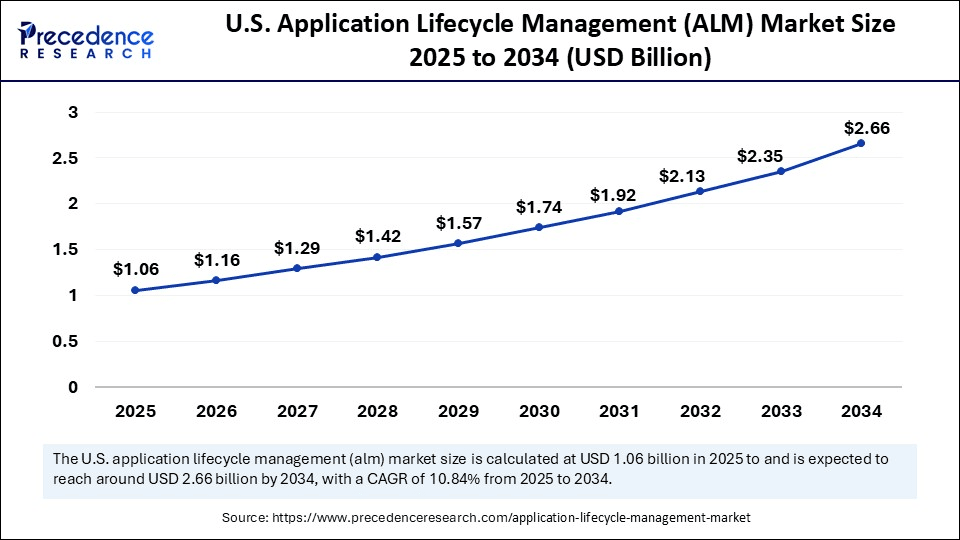
North America
Why North America is Dominating the Application Lifecycle Management Market?
North America is leading the application life cycle management market. The dominance of the North America region in the ALM market is attributed to the robust digital infrastructure available in the region, with early adoption of cloud technology. On a significant level, leading technology firms in the ALM market are concentrated in this region. With massive software demand, the region is strongly focused on agile development methodology, supported by substantial investments in application lifecycle management tools and platform development, which is driving the dominance of this region in this market. Research and development in the ALM market with the adoption of new technology, such as cloud computing, AI, and machine learning, is driving the market growth continuously, and is expected to keep the dominance of the region in the upcoming period.
The competitive market is also leading to adapt cutting-edge technology in the ALM software to continuously meet evolving customer needs. Major industries in the region like BFSI, health care, manufacturing, telecommunication have deep penetration of ALM software's which is also creating a significant requirement of security and compliances which is pushing the governments bring regulations like HIPAA and CCPA particularly in the US which is boosting the ALM solution market while ensuring the data security and compliance in the application life cycle.
Europe
What is Driving Notable Growth in The European ALM Market?
A notable growth is observed in the European region in the application life cycle management market. As the volume and complexity of software are increasing, the demand for robust ALM solutions has become essential for efficient, streamlined processes. The entire software life cycle is encompassed by the AML solutions.From planning development and deployment to maintenance, all processes are organised with proper collaboration and ensuring software quality as per the industry standard. European industry is going through a heavy digital transformation with substantial investments, which is driving the requirement for robust ALM solutions to manage complex software development projects and ensure seamless integration of the latest technology.The adoption of agile and DevOps methodologies is continuously creating the necessity of ALM solutions to provide the essential support in continuous integration, automated testing, and rapid deployment of software tools and projects.GDPR is one of the well-known regulatory requirements introduced in the European region for the implementation of ALM solutions to ensure compliance throughout the software development life cycle.
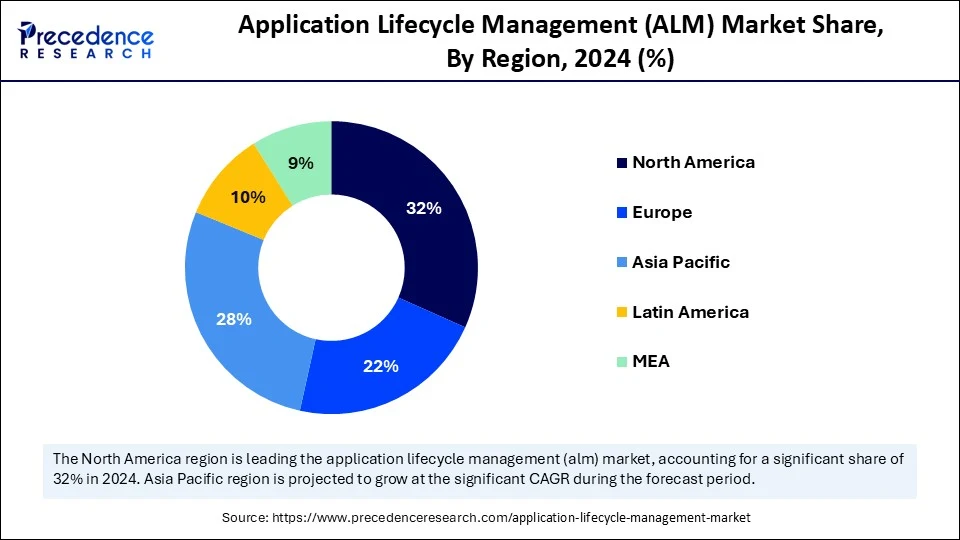
Asia-Pacific
What is Leading to the Fastest Growth in the Asia-Pacific in the Application Lifecycle Management Market?
The Asia Pacific region is showing the fastest growth rate in the application lifecycle management market. The rapid growth of the ALM market in the Asia Pacific region is attributed to the growth of digital transformation, government regulations, and the expanding software development industry.Many startups or rising in the Asia Pacific regions, particularly in countries like India and China, which are significantly contributing to the growing ALM market due to the increasing need for scalable and efficient ALM systems. Adoption of cloud computing is increasing on a very large scale in the Asia Pacific region, with increased use of agile and DevOps methodologies to ensure collaboration and automation in the development and deployment of software using robust ALM solutions.The rise of internet of things (IoT) with integrated ALM solutions is further boosting the capabilities of ALM platforms, specifically in industries where real-time performance and quality management are highly essential.
What Made the European Region grow at a significant rate in the Application Lifecycle Management Market?
Europe experienced a significant uptick due to software quality improvements, adherence to strict regulations, and the need to modernize outdated systems. The excellent embrace of cloud platforms, agile workflows, and cybersecurity solutions supported greater usage of ALM solutions. Industries such as automotive, banking, and manufacturing sought better lifecycle tracing as their goods continued to become digital.
Germany Application Lifecycle Management (ALM) Market Trends
Germany led the European market, and its commitment to advanced manufacturing, automotive, and industrial industries fueled the ALM market, as its sector requires them to effectively manage complex software applications. Industry focused on high-quality development and extensive documentation produced a need for more ALM. Investments in IoT, cloud, and smart factories also contributed to growth. Germany's strong engineering culture and the expansion of digital support vendors with enhanced lifecycle automation and quality tracking across enterprise environments.
Asia Pacific: China Application Lifecycle Management (ALM) Market Trends
China's market is rapidly expanding as digital transformation accelerates across enterprises, especially in manufacturing, telecom, and e commerce. There is growing adoption of agile and DevOps practices, which is boosting demand for integrated ALM platforms that support planning, development, testing, deployment, and monitoring. Cloud native and hosted ALM solutions are seeing strong traction in China, driven by scalability, remote collaboration, and lower maintenance. Vendors are increasingly embedding AI and predictive analytics into their ALM tools to improve project planning, code quality, and risk detection.
Why did the Latin American market grow rapidly in the Application Lifecycle Management Market?
An increase in the number of companies moving to the cloud and a strong emphasis on digital transformation resulted in strong growth across Latin America. Enterprises in banking, telecom, and retail started using ALM tools to modernize legacy systems and enable better collaboration. The rapidly growing startup landscape and increased tech talent in the region also supported greater adoption. Vendors identified opportunities because local enterprises sought new tools to reduce time spent across projects, improve software quality, and provide transparency into development workflows across burgeoning industries.
Brazil Application Lifecycle Management (ALM) Market Trends
Brazil led the ALM market within Latin America, which had a large IT sector and was aggressively implementing digital transformation programs. Companies in the finance, telecommunications, and e-commerce categories implemented ALM solutions to manage complex development lifecycles. Increasing the adoption of cloud solutions, as well as a growing developer community, continued to drive growth. Brazil also generated opportunities for vendors as demand began to grow for DevOps, automated testing, and secure lifecycle management tools across rapidly growing enterprise environments.
Why did the Middle East & Africa Region Experience Strong Growth in the Application Lifecycle Management Market?
The Middle East & Africa region experienced strong growth because governments were investing heavily in digital transformation, cloud infrastructure, and cybersecurity. Companies in finance, energy, and public sectors adopted ALM tools to improve management efficiency, enhance project visibility, and mitigate risks. The region also provided prospects as many firms began transitioning to agile development and, thus, there was a requirement to apply structured workflows to leverage operational activities.
The UAE Application Lifecycle Management (ALM) Market Trends
The UAE was the forerunner in the region, as it committed significantly to smart government programs, cloud adoption, and developing advanced digital services. Nationally, firms in finance, aviation, and the public sector utilize ALM tools to provide greater visibility and management of complex software systems. Furthermore, strong national strategies espousing AI adoption and automation practices motivated ALM to use it with broader organizations.
Recent Developments
- In April 2025, Flexagon, one of the leading DevOps software vendors and a portfolio company of Main Capital Partners, acquired Rookery Software, a UK-based provider of Configuration Management Services for the Oracle applications ecosystem. Rookery software offers Lifecycle Management Solutions for the Oracle ecosystem. By merging resources with Rookery software, Flexagon is going to expand its current DevOps capabilities in the configuration management on automation space for Oracle customers, and it will also increase its strength in its presence in the European and international markets.
(Source: https://www.themiddlemarket.com) - In March 2025, a Key player in the ALM solution market, PTC, launched its new product code Codebeamer 3.0, with enhanced speed and scalability with variant management. This product will help customers accelerate development speed while ensuring compliance with the help of modern branching methods and scaled working sets. This product emphasizes sustainability templates, considering eco-friendly designs, best practices, and decreased physical prototypes with the help of reuse. It enables end-to-end traceability and process support for product compliance in regulated industries.
(Source: https://www.ptc.com)
Application Lifecycle Management Market Companies
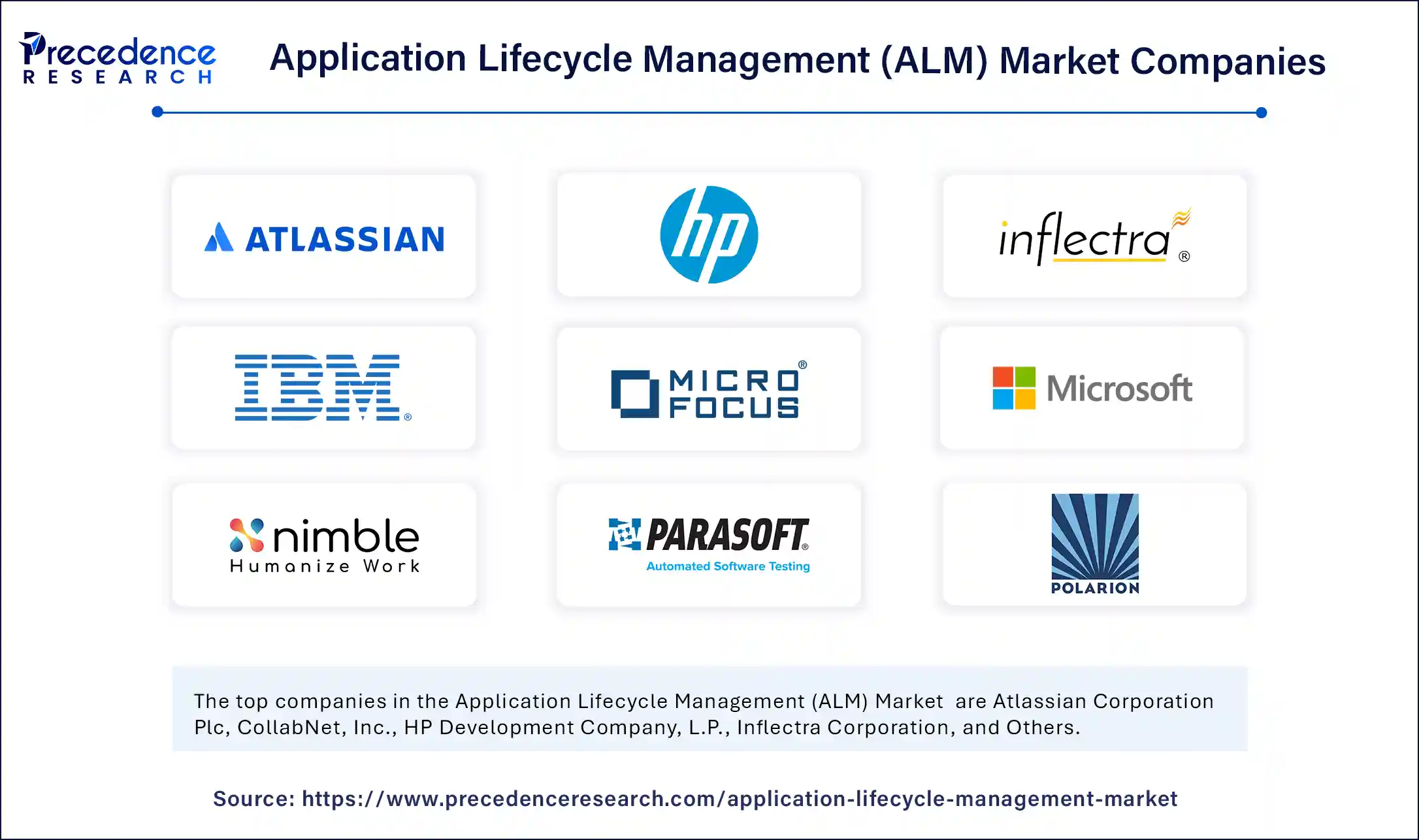
- Atlassian Corporation Plc
- CollabNet, Inc.
- HP Development Company, L.P.
- Inflectra Corporation
- International Business Machines Corporation (IBM)
- Micro Focus International plc
- Microsoft
- NimbleWork, Inc.
- Parasoft Corporation
- Polarion Software GmbH
- SAP SE
Segments covered in the Report
By Component
- Software/Platform
- Requirements Management Tools
- Quality Assurance / Testing Tools
- Integration & Collaboration Tools
- Deployment & Release Automation
- Services
- Consulting
- Integration & Implementation
- Support & Maintenance
- Managed Services
- Training & Education
By Deployment Mode
- On-Premises
- Cloud (SaaS-based ALM platforms)
By Enterprise Size
- Large Enterprises
- Small and Medium-sized Enterprises (SMEs)
By Platform
- Web-based Applications
- Mobile-based Applications
- Desktop/Traditional Software Projects
- Embedded Systems
By Industry Vertical
- Banking, Financial Services, and Insurance (BFSI)
- Information Technology & Telecom
- Healthcare & Life Sciences
- Manufacturing
- Retail & eCommerce
- Energy & Utilities
- Government & Public Sector
- Aerospace & Defense
- Automotive
- Education
- Media & Entertainment
By Region
- North America
- Europe
- Asia Pacific
- Latin America
- Middle East
- Africa
For inquiries regarding discounts, bulk purchases, or customization requests, please contact us at sales@precedenceresearch.com
Frequently Asked Questions
Ask For Sample
No cookie-cutter, only authentic analysis – take the 1st step to become a Precedence Research client
 sales@precedenceresearch.com
sales@precedenceresearch.com
 +1 804-441-9344
+1 804-441-9344